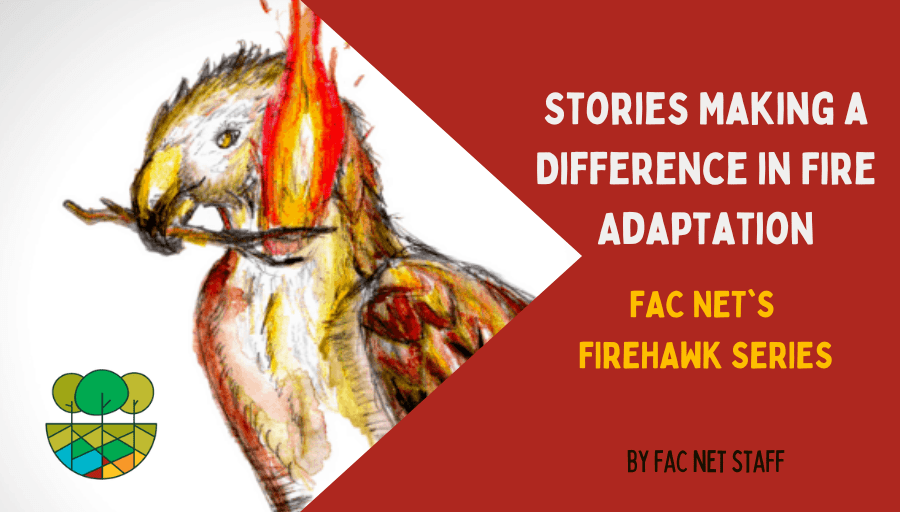Here at FAC Net, we are proud to offer a platform for the many voices of fire adaptation. We strive to create an open learning environment where a variety of perspectives can be heard. Our blog is a home to stories from our members practicing fire adaptation on the ground, interviews with influential figures in fire, and much more. A special element of our blog is the Firehawk Series, a collection of blog posts that give authors a chance to speak openly about real issues facing us as fire practitioners. We ask authors to be bold, tackle the hard questions, and in many cases, challenge the status quo.
The series kicked off in the spring of 2020 (a time of great significance for the world), and we are happy to see it continue and grow. The title Project Firehawk is in reference to a cohort of Australian birds called Firehawks who carry fire in their beaks to spark change. Firehawk blog posts are written by diverse practitioners who reside around the world and a published post does not necessarily indicate an endorsement by FAC Net, network members, or funders. Below is a recap of the series thus far – and an invitation to turn over the ideas from this series in your mind, even if they may challenge your perspective.
 Project Firehawk: Risk, Ripeness, and the Case for Paper Bags
Project Firehawk: Risk, Ripeness, and the Case for Paper Bags
Annie Schmidt, FAC Net’s Policy and Partnerships Director, kicked off the Firehawk series in May 2020 with a piece on risk assessments and how to approach community risk reduction in a realistic way. She writes, “Traditional risk maps don’t tell us whether or not communities have the capacity or the will to address collective risk. These risk maps can’t tell us what the actual return on investment will be in terms of behavior change or voluntary action. Risk maps only tell us where we have risk, not where we will see community-driven risk reduction.”
 The Land Makes it Right: Reframing Our Ideas About When Burning is Possible
The Land Makes it Right: Reframing Our Ideas About When Burning is Possible
Will Harling, Director of the Mid-Klamath Watershed Council, wrote in July 2020 about the delicate but crucial balance between the land, the people, and the relationships that tie them all together when it comes to productive intentional fire. “Tired of seeing these burn windows pass us by, we took a page out of the Forest Stewards Guild’s All Hands All Lands approach to year-round interagency burning and began developing a local inter-agency burn team. While the scaffolding of agreements and formal structure is still being developed, we were able to put many of the practices into play this summer to redefine our prescribed burn season and expand the scope of what was possible.”
 Project Firehawk: Decolonizing Prescribed Fire
Project Firehawk: Decolonizing Prescribed Fire
Christopher Adlam, Regional Fire Specialist at Oregon State University Extension Fire Program and Deniss Martinez, PhD Candidate in Ecology at the University of California, Davis wrote an incredible piece for the Firehawk series in January 2021 on traditional and Indigenous fire practices. In the post, they get real and honest about the impacts to Indigenous people from the colonization of their lands and their fire practices, as well as share a wealth of thought provoking articles and research. They write, “Many fire researchers and professionals seem comfortable acknowledging the historical role of Indigenous burning and will mention it in their publications and management plans. However, this is not always done, or it is done in the past tense, or as a symbolic footnote. This is not enough.”
 Project Firehawk: The WUI is Dead. Long Live the WUI.
Project Firehawk: The WUI is Dead. Long Live the WUI.
Ed Keith, former County Forester in Deschutes County, Oregon, takes on the concept and practices around the Wildland Urban Interface (WUI). He writes, “When I really start to think about it, using the term WUI oversimplifies the landscape it tries to represent, with all its complex social, political, economic and environmental issues overlaid on an ever changing geography. It implies there are areas in our communities without any risk, it allows us (from residents to decision-makers) to point the finger of blame and transmission at ‘others’ or those who live somewhere else, and our obsession over mapping it perfectly keeps us from dealing with the real issues of adaptation and resilience our communities face.”
 California Burn Boss Program: New Path Forward or Dead-End Street?
California Burn Boss Program: New Path Forward or Dead-End Street?
Lenya Quinn-Davidson, Fire Advisor with the University of California Cooperative Extension, wrote an influential piece on the delays experienced by students of the California state-certified burn boss program in getting their certifications recognized by the state. “We’ve built a fire culture that doesn’t recognize—and often undermines—other forms of knowledge, to the great detriment of our landscapes and communities. So if the existing rules and standards don’t facilitate the right things, let’s change the rules. Let’s re-write the standards. Let’s honor the innovative work that people have been doing, and let’s choose leaders who think outside the box.” Her piece made waves – soon after it was published, CAL FIRE issued course certificates and task books to almost everyone that had taken the May 2021 course series.
Many thanks to our Firehawk authors, both those represented here and those that may write for us in the future. Opening up dialogue and having conversations that matter are critical as we move forward towards fire adaptation.
Do you have an idea for a blog post that would fit well in the Firehawk Series? Pitch us! We are always looking for more stories, perspectives, and wisdom to share on this platform.
****

